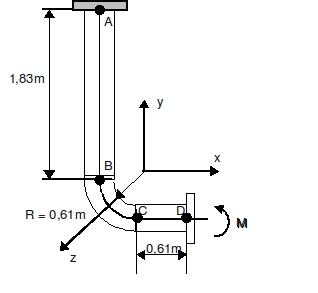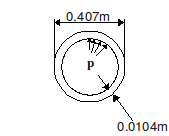1. Reference problem#
1.1. Geometry#


1.2. Material properties#
The properties of the material from which the pipe is made are:
\(E\mathrm{=}193.{10}^{9}\mathit{Pa}\) |
Young’s module |
\(\nu \mathrm{=}0.2642\) |
Poisson’s ratio |

|
Constraint \(\mathrm{Pa}\) |
Plastic Deformation \({\varepsilon }_{p}\) |
2.72E+08 3.46E+08 3.79E+08 4.04E+08 4.24E+08 5.28E+08 |
0.00000 0.00473 0.01264 0.01264 0.02836 0.04910 0.10500 |
|
1.3. Boundary conditions and loads#
Boundary conditions:
◦ Recessed section \(A\)
◦ Rigid section \(D\) (no deformation of the section)
Loading: we are looking for the successive states of equilibrium under the following loads:
◦ Step A: \(0\mathrm{=}t<{t}_{1}\)
▪ the pressure varies from \(0\) to \(3.45{10}^{6}\mathrm{Pa}\)
▪ The strength (shape effect) at point \(D\) varies from \(0\) to \(4.0414{10}^{5}N\)
▪ The moment sucks
◦ Step B: \({t}_{1}\mathrm{=}t<{t}_{2}\)
▪ the pressure is constant and is \(3.45{10}^{6}\mathrm{Pa}\)
▪ the force (shape effect) at point \(D\) is constant and is equal to \(4.0414{10}^{5}N\)
▪ the timing varies from \(0\) to \(2.534{10}^{5}\mathit{N.m}\)